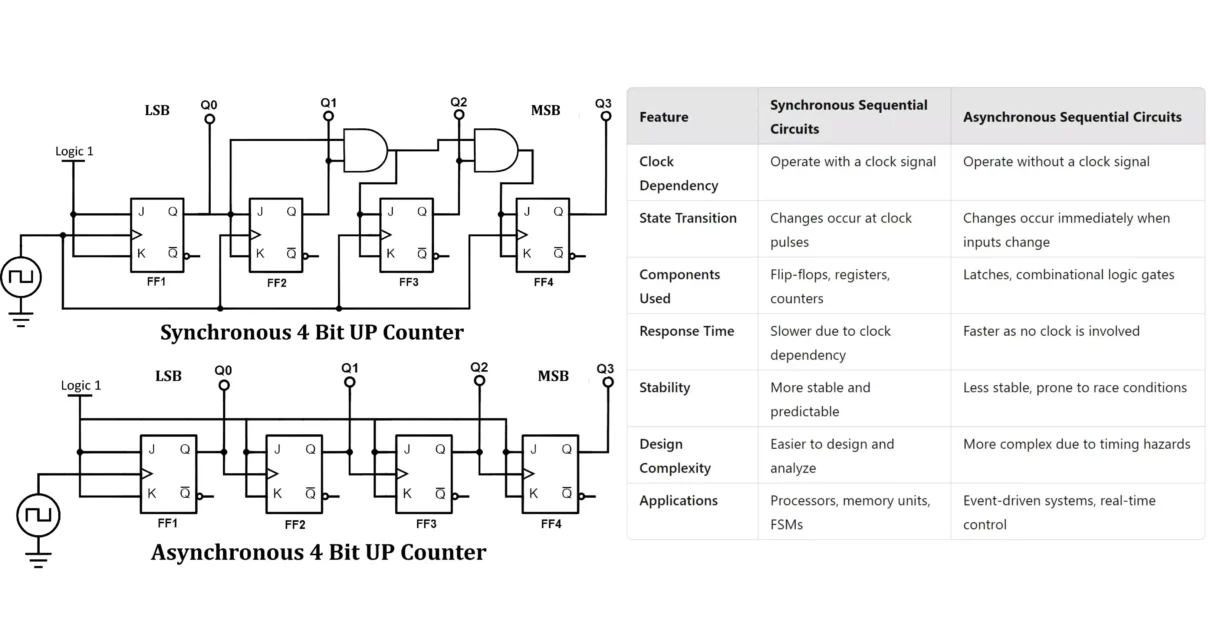Sequential circuits are of two types: Synchronous Sequential Circuits and Asynchronous Sequential Circuits. The difference between them is that synchronous circuits use a clock signal to control state changes, making them more predictable and easier to design. In contrast, asynchronous circuits do not rely on a clock and change states based on input signals, which can make them faster but harder to manage due to timing issues.
Sequential circuits are a fundamental part of digital electronics, playing a crucial role in memory storage, processing, and automation. Unlike combinational circuits, which depend only on current inputs, sequential circuits have memory elements that store past inputs, influencing their current state. Understanding their working, differences, and applications is important for designing efficient digital systems like processors and communication devices.
Synchronous Sequential Circuits
A synchronous sequential circuit operates in synchronization with a clock signal. The changes in the state of the circuit occur only at discrete time intervals, determined by clock pulses.
Working Principle:
- These circuits consist of flip-flops, which act as memory elements.
- The circuit transitions from one state to another only when a clock pulse is applied.
- Inputs are sampled only at specific time instances (during clock transitions).
- Synchronization ensures stability and predictability.
Example Components:
- Flip-flops (D, T, JK, and SR Flip-Flops)
- Counters (Binary Counters, Ring Counters, Johnson Counters)
- Registers (Shift Registers, Storage Registers)
- Finite State Machines (FSMs)
Advantages:
- Reliable operation due to clock synchronization.
- Predictable state transitions.
- Easier to design and analyze using state diagrams.
Disadvantages:
- Higher power consumption due to continuous clock operation.
- Increased complexity in clock distribution and management.
Applications:
- Microprocessors and microcontrollers.
- Digital counters and registers.
- Memory units (RAM, ROM, and cache memory).
- Finite state machines (FSMs) in control systems.
- Synchronous communication protocols (I2C, SPI, etc.).
Asynchronous Sequential Circuits
An asynchronous sequential circuit does not rely on a clock signal. Instead, the state transitions occur immediately based on changes in input signals.
Working Principle:
- These circuits use logic gates and latches (instead of flip-flops) to store states.
- Inputs directly influence the output without waiting for a clock pulse.
- They operate faster since they are not limited by clock cycles.
- However, they can be prone to instability due to race conditions.
Example Components:
- Latches (SR Latch, D Latch)
- Pulse-mode circuits
- Asynchronous counters
- Self-timed logic circuits
Advantages:
- Faster response time due to the absence of clock dependency.
- Lower power consumption in some cases (no clock pulses driving state changes).
- Efficient in real-time applications where immediate response is required.
Disadvantages:
- Difficult to design due to unpredictable state transitions.
- Susceptible to glitches and race conditions.
- Harder to debug and analyze compared to synchronous circuits.
Applications:
- Handshake-based data communication systems.
- Event-driven control systems (traffic light controllers, elevator controllers).
- Power-efficient electronics (such as sensors in IoT devices).
- Asynchronous data transmission (UART, Ethernet, etc.).
Differences Between Synchronous and Asynchronous Sequential Circuits
| Feature | Synchronous Sequential Circuits | Asynchronous Sequential Circuits |
|---|---|---|
| Clock Dependency | Operate with a clock signal | Operate without a clock signal |
| State Transition | Changes occur at clock pulses | Changes occur immediately when inputs change |
| Components Used | Flip-flops, registers, counters | Latches, combinational logic gates |
| Response Time | Slower due to clock dependency | Faster as no clock is involved |
| Stability | More stable and predictable | Less stable, prone to race conditions |
| Design Complexity | Easier to design and analyze | More complex due to timing hazards |
| Applications | Processors, memory units, FSMs | Event-driven systems, real-time control |
Conclusion
Synchronous and asynchronous sequential circuits play a vital role in digital electronics. While synchronous circuits offer reliability and ease of design, asynchronous circuits provide faster operation and efficiency in real-time applications. Understanding their characteristics and differences helps engineers choose the right circuit for their specific applications.
FAQs on Synchronous and Asynchronous Sequential Circuits
Q1: Why are synchronous circuits preferred in digital systems?
Synchronous circuits are preferred because they offer predictable and stable state transitions. The use of a clock signal ensures controlled timing, making them easier to design and analyze.
Q2: Where are asynchronous sequential circuits used?
Asynchronous circuits are used in event-driven applications, such as real-time control systems, handshake protocols, and low-power embedded systems where fast response times are needed.
Q3: What is a race condition in asynchronous circuits?
A race condition occurs when two or more inputs change simultaneously, leading to unpredictable output states. This is a common issue in asynchronous circuits due to their dependence on input signal changes.
Q4: Can an asynchronous circuit be converted into a synchronous one?
Yes, by introducing a clock signal and using flip-flops instead of latches, an asynchronous circuit can be converted into a synchronous circuit.
Q5: How do designers overcome the instability in asynchronous circuits?
Designers use techniques such as hazard elimination, proper delay management, and asynchronous state machines with well-defined state transitions to overcome instability.
Types of Logic Gates with Symbol, Truth Table and IC Numbers



